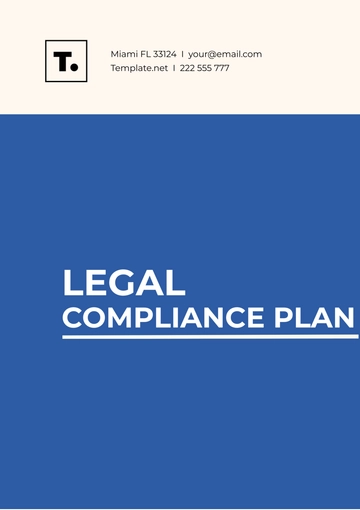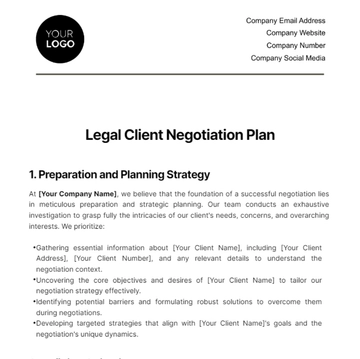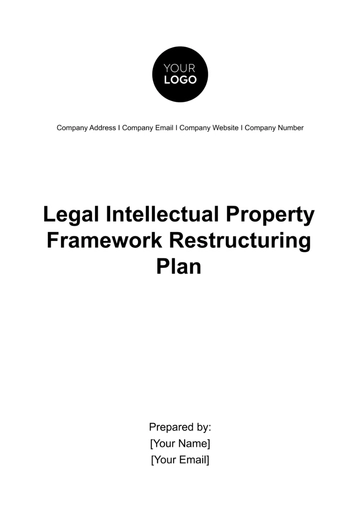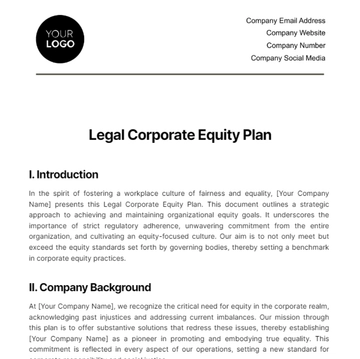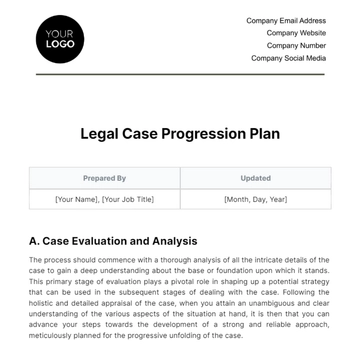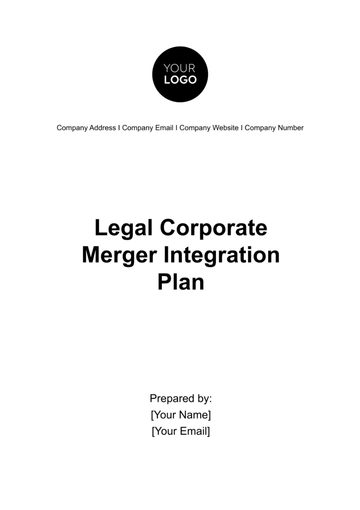Free Legal Intellectual Property Management Plan

I. Introduction
[Your Company Name] recognizes the critical importance of intellectual property (IP) in maintaining its competitive edge, fostering innovation, and driving growth. As such, the company is committed to implementing a comprehensive Legal Intellectual Property Management Plan to effectively manage and safeguard its valuable IP assets. This plan serves as a strategic framework for identifying, protecting, leveraging, and enforcing our intellectual property rights in alignment with legal requirements and industry best practices.
II. Overview of Intellectual Property (IP)
Intellectual property (IP) represents a cornerstone of modern business and innovation, encompassing a diverse array of intangible assets that underpin the competitive advantage and market position of companies worldwide. Understanding the breadth and significance of IP is essential for [Your Company Name] to navigate the intricacies of intellectual property management effectively.
Patents:
Patents provide legal protection for inventions, granting exclusive rights to their creators for a specified period. Inventions eligible for patent protection range from novel products and processes to innovative methods and designs. By securing patents, [Your Company Name] can safeguard its technological advancements and prevent competitors from exploiting its innovations without permission.
Trademarks:
Trademarks serve as symbols of brand identity, distinguishing the products and services of one entity from another in the marketplace. Logos, slogans, brand names, and distinctive packaging elements are common examples of trademarks. By registering trademarks, [Your Company Name] can build brand recognition, foster consumer loyalty, and protect its reputation from unauthorized use or dilution.
Copyrights:
Copyrights safeguard original works of authorship, including literary, artistic, musical, and software creations. These rights afford creators exclusive control over the reproduction, distribution, and adaptation of their works. Whether it's software code, marketing materials, or creative content, copyrights empower [Your Company Name] to control the use and dissemination of its intellectual creations.
Trade Secrets:
Trade secrets comprise confidential information, formulas, or processes that provide a competitive advantage and derive value from their secrecy. Unlike patents, trademarks, or copyrights, trade secrets rely on non-disclosure agreements and robust security measures to maintain their confidentiality. [Your Company Name] relies on trade secrets to safeguard proprietary technologies, formulas, and business strategies from competitors' prying eyes.
Other Proprietary Information:
Beyond the traditional realms of patents, trademarks, copyrights, and trade secrets, [Your Company Name] may possess a wealth of proprietary information unique to its operations. This could include customer databases, research data, manufacturing techniques, or proprietary algorithms. Properly identifying, protecting, and managing this diverse array of intellectual assets is crucial for maintaining [Your Company Name]'s competitive edge and mitigating risks of misappropriation.
III. Purpose of the IP Management Plan
The primary purpose of our IP Management Plan is to:
Identify and classify our IP assets to ensure comprehensive coverage.
Develop strategies to protect and enforce our IP rights against infringement or misappropriation.
Facilitate the registration and documentation of our IP assets to establish legal ownership and enhance their commercial value.
Enable the licensing and commercialization of our IP assets to generate additional revenue streams and foster strategic partnerships.
Mitigate risks associated with IP infringement, litigation, or regulatory non-compliance.
Ensure compliance with relevant legal and regulatory requirements governing intellectual property.
Continuously improve our IP management practices to adapt to evolving business needs and technological advancements.
IV. Identification and Classification of IP Assets
In order to effectively manage its intellectual property (IP) portfolio, [Your Company Name] must conduct a comprehensive assessment to identify, classify, and prioritize its diverse array of IP assets. This process is essential for ensuring that all valuable intellectual creations are properly recognized, protected, and leveraged to their full potential.
The following table outlines the various types of intellectual property (IP) assets held by [Your Company Name], along with a brief description of each asset and its current status. Effective identification and classification of these assets are crucial for [Your Company Name] to prioritize resources, implement protection strategies, and maximize the value of its intellectual capital.
Type of IP | Description | Status |
|---|---|---|
Patents | Inventions, processes, and technological innovations. | Pending |
Trademarks | Brand names, logos, slogans, symbols. | Registered |
Copyrights | Original works of authorship, creative content. | Copyrighted |
Trade Secrets | Confidential information, proprietary know-how. | Protected |
Other | Additional proprietary information unique to the company. | - |
Patents:
The identification of patentable inventions begins with a thorough examination of [Your Company Name]'s research and development activities. This involves reviewing invention disclosures, research reports, and technical documentation to identify innovations eligible for patent protection. Classification of patent assets may include utility patents covering new products or processes, design patents protecting ornamental features, or plant patents for new plant varieties.
Trademarks:
The classification of trademarks involves cataloging the various elements that serve as identifiers of [Your Company Name]'s brand identity. This includes brand names, logos, slogans, and other distinctive symbols used in commerce. By conducting trademark searches and assessments, [Your Company Name] can identify existing marks and evaluate their strength, distinctiveness, and potential for registration.
Copyrights:
Copyrightable works within [Your Company Name]'s portfolio encompass a wide range of creative expressions, including written content, artistic works, software code, and multimedia productions. Identification involves compiling a catalog of original works created by employees or commissioned from third parties. Classification may include literary works, visual arts, musical compositions, software code, and audiovisual productions.
Trade Secrets:
The identification of trade secrets entails identifying confidential information, proprietary processes, or know-how that confers a competitive advantage to [Your Company Name]. This may include proprietary algorithms, manufacturing techniques, customer lists, or strategic business plans. Classification involves assessing the significance, secrecy, and economic value of trade secret assets to prioritize protection measures.
Other Proprietary Information:
Beyond the traditional categories of IP, [Your Company Name] may possess a variety of other proprietary information essential to its operations and competitive advantage. This could include customer databases, research data, market analyses, proprietary software tools, or proprietary formulations. Identification and classification of these assets involve understanding their role in driving value creation and competitive differentiation.
By systematically cataloging and classifying its IP assets, [Your Company Name] can establish a comprehensive inventory of its intellectual capital. This enables the development of targeted strategies for protection, licensing, and commercialization, ensuring that valuable intellectual creations are safeguarded and leveraged to their fullest potential. Additionally, this process allows [Your Company Name] to allocate resources effectively, prioritize investments in IP protection, and mitigate the risk of IP infringement or misappropriation.
V. IP Protection Strategies
Protecting intellectual property (IP) assets is paramount for [Your Company Name] to maintain its competitive edge and safeguard its innovations from unauthorized use or exploitation. Implementing robust IP protection strategies ensures that the value of [Your Company Name]'s intellectual creations is preserved and that the company retains exclusive rights to its innovations. Here are key strategies employed by [Your Company Name] to protect its valuable IP assets:
Confidentiality Measures:
Implementing strict confidentiality measures is essential for safeguarding trade secrets and proprietary information. [Your Company Name] employs non-disclosure agreements (NDAs) with employees, partners, and contractors to ensure that sensitive information remains confidential. Access controls, encryption, and secure data storage systems are utilized to prevent unauthorized access or disclosure of confidential information.
Patent Protection:
Filing for patents is a cornerstone of [Your Company Name]'s IP protection strategy for inventions, processes, and technological innovations. This involves conducting thorough patent searches to assess the novelty and patentability of inventions before filing patent applications. By obtaining patents, [Your Company Name] secures exclusive rights to its innovations, preventing competitors from exploiting or replicating its technology without permission.
Trademark Registration:
Registering trademarks for [Your Company Name]'s brand names, logos, and symbols is crucial for protecting its brand identity and reputation. [Your Company Name] conducts comprehensive trademark searches to ensure that its trademarks are distinct and eligible for registration. Once registered, [Your Company Name] enforces its trademark rights to prevent unauthorized use or infringement by competitors.
Copyright Enforcement:
Asserting copyright protection for original works of authorship is essential for [Your Company Name] to safeguard its creative content and artistic creations. [Your Company Name] includes copyright notices on its website, marketing materials, and digital content to assert its rights and deter infringement. When unauthorized use of copyrighted works is identified, [Your Company Name] takes swift legal action to enforce its rights and seek damages for infringement.
Trade Secret Protection:
Protecting trade secrets and proprietary know-how is critical for maintaining [Your Company Name]'s competitive advantage in the marketplace. [Your Company Name] implements robust security measures, such as access controls, non-disclosure agreements, and employee training programs, to safeguard confidential information. In the event of trade secret misappropriation, [Your Company Name] pursues legal remedies, including injunctive relief and monetary damages, to protect its proprietary information.
Technology Protection:
Implementing technological safeguards is essential for protecting [Your Company Name]'s software code, algorithms, and digital assets from unauthorized use or infringement. [Your Company Name] utilizes encryption, digital rights management (DRM) systems, and software licensing agreements to protect its technology assets. Additionally, [Your Company Name] monitors online platforms and marketplaces for unauthorized distribution or use of its software products.
Strategic Partnerships and Alliances:
Forming strategic partnerships and alliances with trusted collaborators is an effective strategy for protecting [Your Company Name]'s IP assets and expanding its market presence. [Your Company Name] enters into licensing agreements, joint ventures, and technology transfer agreements with strategic partners to leverage their expertise and resources while maintaining control over its IP rights. These partnerships enable [Your Company Name] to access new markets, enhance product offerings, and drive innovation collaboratively.
VI. IP Registration and Documentation
[Your Company Name] will maintain accurate records and documentation of our IP assets to establish legal ownership and enhance their commercial value. This includes:
Patent filings: Documenting the filing dates, jurisdictions, and status of our patent applications to establish priority rights and protect against infringement.
Trademark registrations: Maintaining up-to-date registrations for our trademarks to enforce our exclusive rights and prevent unauthorized use by competitors.
Copyright notices: Including copyright notices on our creative works to assert our rights and deter infringement by providing public notice of our ownership.
Trade secret documentation: Implementing internal policies and procedures to document and protect our trade secrets, including confidentiality agreements and restricted access controls.
By maintaining comprehensive records of our IP assets, we can streamline licensing, enforcement, and commercialization efforts while mitigating disputes over ownership or infringement.
VII. IP Licensing and Commercialization
[Your Company Name] will explore opportunities to license or commercialize our IP assets to generate additional revenue streams and foster strategic partnerships. This includes:
Licensing agreements: Negotiating license agreements with third parties to grant permission to use our patented technologies, trademarks, or copyrighted works in exchange for royalties or fees.
Technology transfer: Collaborating with research institutions, universities, or industry partners to transfer our technology and expertise for commercialization in new markets or applications.
Joint ventures: Forming strategic alliances or joint ventures with complementary businesses to jointly develop, market, or exploit our IP assets for mutual benefit.
Product branding and merchandising: Leveraging our trademarks and copyrights to create branded merchandise or licensing opportunities in consumer markets.
By strategically licensing and commercializing our IP assets, we can maximize their value and broaden our revenue streams while expanding our market presence and brand recognition.
VIII. IP Risk Management
[Your Company Name] will implement proactive measures to mitigate risks associated with IP infringement, litigation, or regulatory non-compliance. This includes:
IP audits: Conducting periodic audits to assess the strength, validity, and enforceability of our IP rights and identify potential areas of vulnerability or exposure.
Risk assessment: Evaluating the likelihood and potential impact of IP infringement or litigation on our business operations, financial performance, and reputation.
Insurance coverage: Obtaining appropriate insurance coverage, such as IP infringement liability insurance, to mitigate financial risks associated with legal disputes or damages.
Legal counsel: Engaging qualified legal counsel with expertise in intellectual property law to provide guidance on IP protection, enforcement, and compliance matters.
By proactively managing IP risks, we can safeguard our business interests and protect the value of our intellectual property assets in an increasingly competitive and complex marketplace.
IX. Compliance with Legal and Regulatory Requirements
[Your Company Name] is committed to ensuring compliance with all applicable legal and regulatory requirements governing intellectual property rights. This includes:
Patent, trademark, and copyright laws: Adhering to national and international laws and regulations governing the registration, enforcement, and protection of our IP rights.
Trade secret protection: Implementing measures to comply with trade secret laws and regulations, including the Uniform Trade Secrets Act (UTSA) and the Defend Trade Secrets Act (DTSA).
Data privacy and security: Protecting the confidentiality and integrity of our IP assets in compliance with data privacy laws, such as the General Data Protection Regulation (GDPR) and the California Consumer Privacy Act (CCPA).
Export control and sanctions: Ensuring compliance with export control laws and regulations, such as the Export Administration Regulations (EAR) and the International Traffic in Arms Regulations (ITAR), to prevent unauthorized export of controlled technologies or products.
By maintaining strict compliance with legal and regulatory requirements, we can minimize the risk of legal disputes, regulatory penalties, and reputational damage while upholding the integrity of our intellectual property assets.
X. Continuous Improvement Initiatives
[Your Company Name] will continuously monitor and evaluate our IP management practices to identify opportunities for improvement and adaptation to evolving business needs and technological advancements. This includes:
Performance metrics: Establishing key performance indicators (KPIs) to measure the effectiveness of our IP management efforts, such as the number of patents filed, trademarks registered, or licensing revenue generated.
Stakeholder feedback: Soliciting feedback from internal stakeholders, including R&D teams, legal counsel, and business units, to identify areas for optimization or enhancement in our IP management processes.
Industry benchmarking: Benchmarking our IP management practices against industry peers and best-in-class organizations to identify leading practices and emerging trends for adoption.
Training and education: Providing ongoing training and education to employees on intellectual property rights, protection strategies, and compliance requirements to enhance awareness and promote a culture of IP stewardship.
By embracing a culture of continuous improvement, [Your Company Name] can adapt to changes in the competitive landscape and regulatory environment while maximizing the value and impact of our intellectual property assets.
XI. Conclusion
[Your Company Name] is committed to implementing and upholding the principles outlined in this Legal Intellectual Property Management Plan to effectively manage and safeguard our intellectual property assets. By prioritizing the identification, protection, licensing, and enforcement of our IP rights, we can drive innovation, foster growth, and maintain our competitive advantage in the marketplace. Through continuous improvement and adherence to legal and regulatory requirements, we will ensure the integrity and value of our intellectual property assets for the benefit of our stakeholders and the sustainable success of our business.
- 100% Customizable, free editor
- Access 1 Million+ Templates, photo’s & graphics
- Download or share as a template
- Click and replace photos, graphics, text, backgrounds
- Resize, crop, AI write & more
- Access advanced editor
Safeguard your intellectual property with Template.net's Legal Intellectual Property Management Plan Template. This customizable template, supported by our AI Editor Tool, simplifies IP management. With editable sections and comprehensive strategies, you can develop a tailored plan to protect and maximize the value of your intellectual assets, ensuring legal compliance and strategic advantage.
You may also like
- Finance Plan
- Construction Plan
- Sales Plan
- Development Plan
- Career Plan
- Budget Plan
- HR Plan
- Education Plan
- Transition Plan
- Work Plan
- Training Plan
- Communication Plan
- Operation Plan
- Health And Safety Plan
- Strategy Plan
- Professional Development Plan
- Advertising Plan
- Risk Management Plan
- Restaurant Plan
- School Plan
- Nursing Home Patient Care Plan
- Nursing Care Plan
- Plan Event
- Startup Plan
- Social Media Plan
- Staffing Plan
- Annual Plan
- Content Plan
- Payment Plan
- Implementation Plan
- Hotel Plan
- Workout Plan
- Accounting Plan
- Campaign Plan
- Essay Plan
- 30 60 90 Day Plan
- Research Plan
- Recruitment Plan
- 90 Day Plan
- Quarterly Plan
- Emergency Plan
- 5 Year Plan
- Gym Plan
- Personal Plan
- IT and Software Plan
- Treatment Plan
- Real Estate Plan
- Law Firm Plan
- Healthcare Plan
- Improvement Plan
- Media Plan
- 5 Year Business Plan
- Learning Plan
- Marketing Campaign Plan
- Travel Agency Plan
- Cleaning Services Plan
- Interior Design Plan
- Performance Plan
- PR Plan
- Birth Plan
- Life Plan
- SEO Plan
- Disaster Recovery Plan
- Continuity Plan
- Launch Plan
- Legal Plan
- Behavior Plan
- Performance Improvement Plan
- Salon Plan
- Security Plan
- Security Management Plan
- Employee Development Plan
- Quality Plan
- Service Improvement Plan
- Growth Plan
- Incident Response Plan
- Basketball Plan
- Emergency Action Plan
- Product Launch Plan
- Spa Plan
- Employee Training Plan
- Data Analysis Plan
- Employee Action Plan
- Territory Plan
- Audit Plan
- Classroom Plan
- Activity Plan
- Parenting Plan
- Care Plan
- Project Execution Plan
- Exercise Plan
- Internship Plan
- Software Development Plan
- Continuous Improvement Plan
- Leave Plan
- 90 Day Sales Plan
- Advertising Agency Plan
- Employee Transition Plan
- Smart Action Plan
- Workplace Safety Plan
- Behavior Change Plan
- Contingency Plan
- Continuity of Operations Plan
- Health Plan
- Quality Control Plan
- Self Plan
- Sports Development Plan
- Change Management Plan
- Ecommerce Plan
- Personal Financial Plan
- Process Improvement Plan
- 30-60-90 Day Sales Plan
- Crisis Management Plan
- Engagement Plan
- Execution Plan
- Pandemic Plan
- Quality Assurance Plan
- Service Continuity Plan
- Agile Project Plan
- Fundraising Plan
- Job Transition Plan
- Asset Maintenance Plan
- Maintenance Plan
- Software Test Plan
- Staff Training and Development Plan
- 3 Year Plan
- Brand Activation Plan
- Release Plan
- Resource Plan
- Risk Mitigation Plan
- Teacher Plan
- 30 60 90 Day Plan for New Manager
- Food Safety Plan
- Food Truck Plan
- Hiring Plan
- Quality Management Plan
- Wellness Plan
- Behavior Intervention Plan
- Bonus Plan
- Investment Plan
- Maternity Leave Plan
- Pandemic Response Plan
- Succession Planning
- Coaching Plan
- Configuration Management Plan
- Remote Work Plan
- Self Care Plan
- Teaching Plan
- 100-Day Plan
- HACCP Plan
- Student Plan
- Sustainability Plan
- 30 60 90 Day Plan for Interview
- Access Plan
- Site Specific Safety Plan


